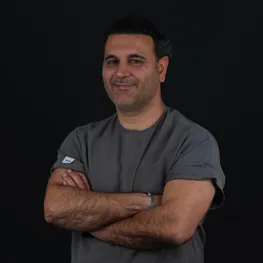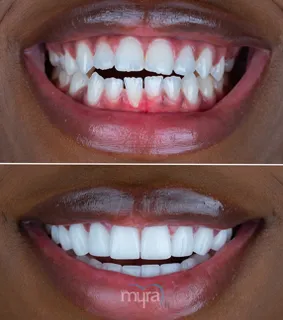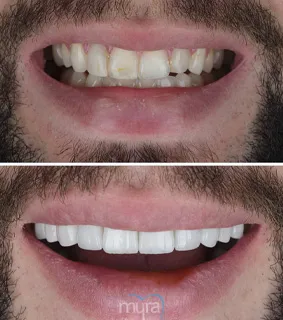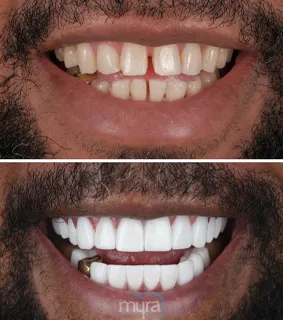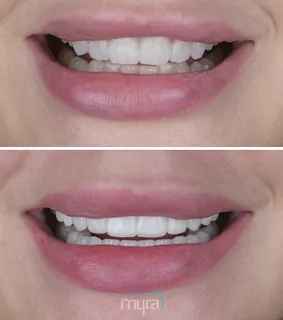A narrow smile, often known as a "thin smile" or "tight smile," is a dental condition in which a person's smile appears narrower than usual due to various circumstances. A narrow smile usually indicates that when a person smiles, either their upper teeth or their lower teeth do not show a wide and attractive arch, which has an impact on their entire facial look and self-confidence. Smiles are uniquely defined expressions that vary from a narrow smile to a wide smile, reflecting individual preferences in how to smile. It's essential to consider the subtleties of a teeth smile versus a big teeth smile, as they convey different emotions and moods when learning how to smile.
A narrow smile is caused by a number of factors. Genetics is one of the main contributing factors. Some people naturally have shorter dental arches, which lead to a narrow grin. Other factors that contribute to dental arch development issues include malocclusion, in which teeth are not aligned properly, dental crowding, tooth loss, and activities such as thumb-sucking during childhood. A narrow smile is a result of mouth trauma or injury, poor dental restorations, and specific orthodontic procedures that solely work on straightening teeth without taking smile aesthetics into account.
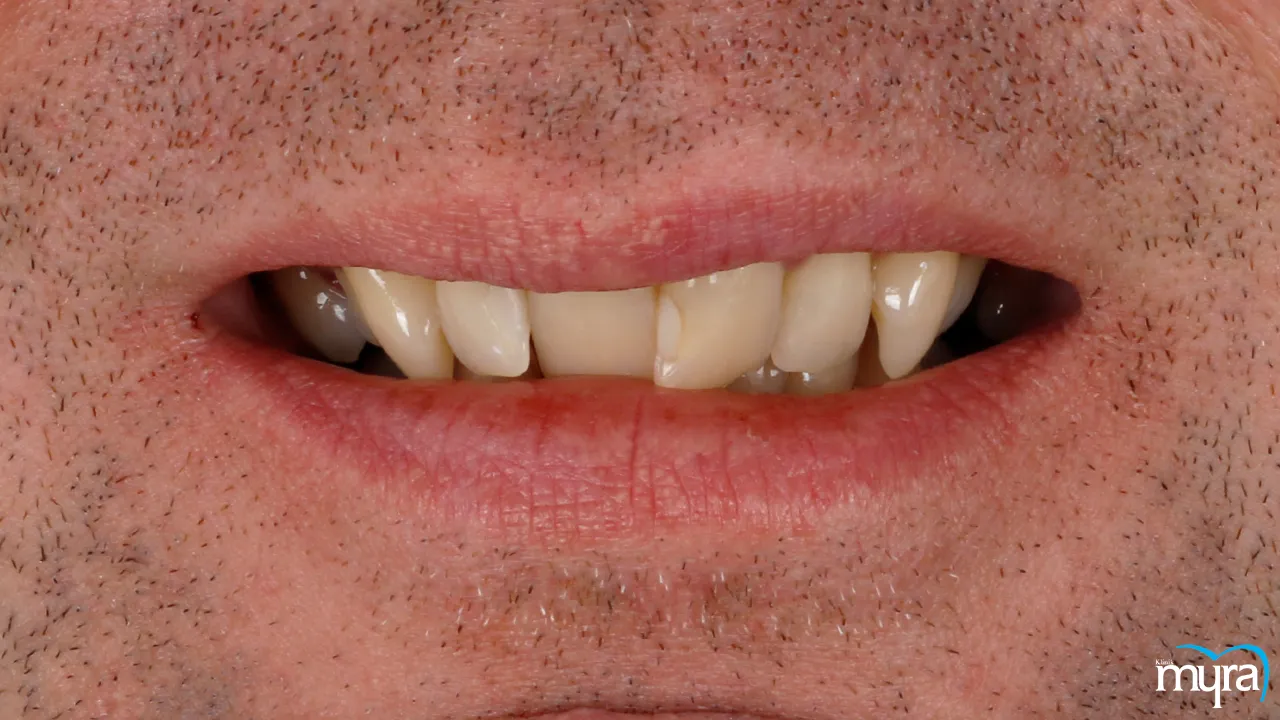
A dental and orthodontic procedure combination is frequently used to treat a narrow smile. The dental arch is widened, and mismatched teeth are fixed with orthodontic therapy such as braces or clear aligners. Cosmetic dentistry procedures such as veneers or dental bonding are recommended in some circumstances to produce the appearance of a wider smile. Severe cases warrant surgical procedures such as orthognathic surgery, which realigns the jaw. Patients must consult a trained dentist or orthodontist to establish the best treatment for a narrow smile because treatment plans differ depending on each patient's needs.
The price of treating a narrow smile differs greatly based on the precise procedure required, the seriousness of the problem, and the practice's location. The cost of orthodontic treatment, such as braces, is between £1,500 and £10,000. The cost of transparent braces is between £1,500 and £5,500, self-ligating braces between £2,000 and £6,000, and lingual orthodontics between £3,000 and £10,000. Veneers are often more expensive than bonding or other cosmetic dentistry procedures, but prices vary. The most expensive method is typically surgery, such as orthognathic surgery. It's advisable to verify with the insurer and discuss payment options with one's dental care provider before making a decision because some of these treatments are covered by dental insurance.
Narrow smiles and gummy smiles make a person's smile look bad, but they are not the same thing. A narrow smile isn't a wide smile because of the position of the teeth or the form of the dental arch. A gummy smile is distinguished by excessive gum tissue exposure when smiling, frequently making the gums more obvious than the teeth. A high ratio of gum to teeth or overactive upper lip muscles causes gummy smiles. A gummy smile is treated with braces, gum contouring surgery, or Botox injections to calm the hyperactive muscles. The precise diagnosis and the patient's cosmetic objectives determine whether to treat a narrow smile or a gummy smile, and a knowledgeable dental practitioner assists in determining the best course of action.
What is a Narrow Smile?
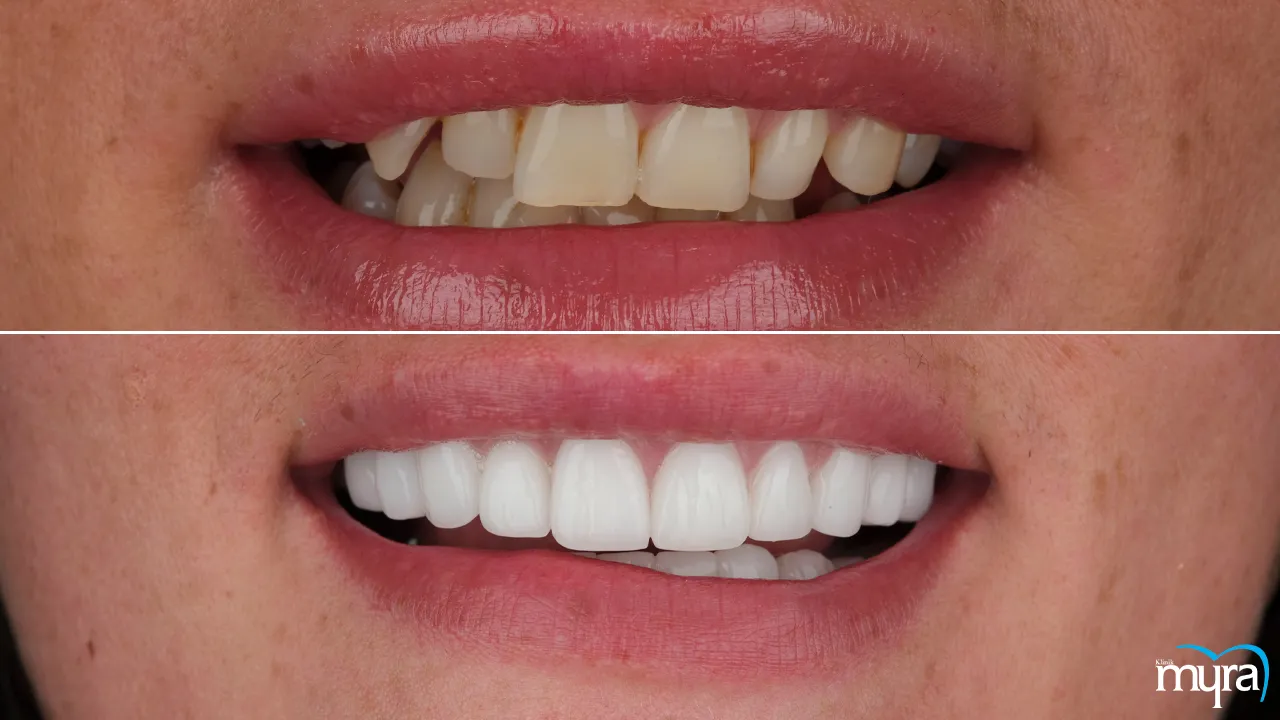
A narrow smile, often known as a "thin smile" or "tight smile," is a dental issue that largely affects a person's smile's width and overall look. An attractive and balanced smile is mostly a result of the interaction between an individual's upper and lower teeth and the oral tissues that surround them. The balance is broken in the case of a narrow smile since the width of the smile appears narrower than what is regarded as desirable or aesthetically attractive.
One of the main traits of a narrow smile is that the teeth do not show in a broad, symmetrical arch when someone smiles. A narrow smile frequently exposes a more compressed appearance, where the teeth appear closely packed together rather than exhibiting a well-aligned set of teeth that naturally fills the mouth. It leads to an uneven distribution of teeth across the width of the smile, producing an aesthetic imbalance in the face as a whole.
A smile's width differs from person to person, and what one person perceives as a thin smile is different for another. A narrow smile is caused by genetics, dental disorders such as malocclusion or misalignment of teeth, dental crowding, missing teeth, or childhood activities such as thumb-sucking, which impair the development of the dental arch. A narrow smile has its roots in oral trauma or injury, poor dental restorations, and specific orthodontic procedures that put the health of the teeth above the appearance of the smile.
What are the causes of Narrow Smile?
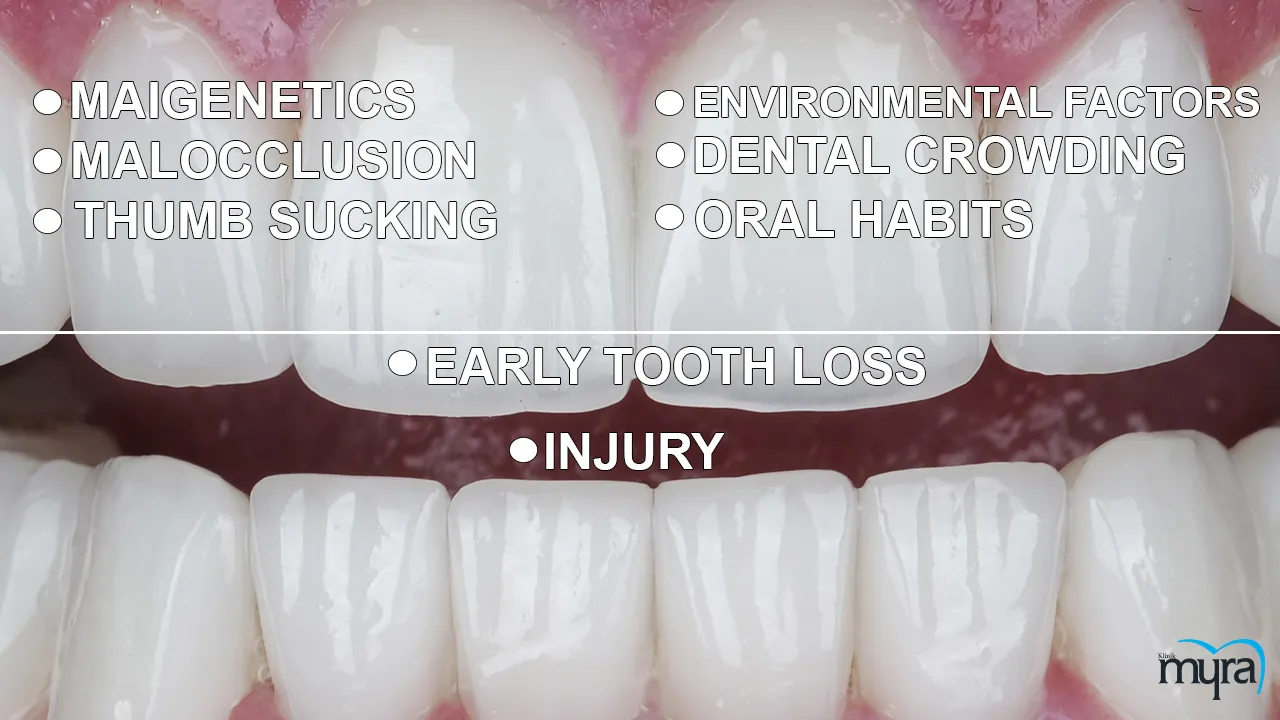
The causes of a narrow smile are listed below.
- Genetics: Genetics have a crucial impact in determining the size and shape of a person's dental arches and, consequently, their smile. Some people naturally have narrower smiles because they were born with narrower dental arches.
- Malocclusion: Malocclusion is the term for the misalignment of the teeth, which results in them being too close together or not spaced evenly. The teeth are not distributed evenly over the dental arch due to such misalignment, which leads to a narrow smile.
- Thumb Sucking: Using pacifiers or thumb sucking for an extended period of time while a youngster causes stress on the developing dental arches. The arches change shape due to the pressure, resulting in a narrow smile.
- Environmental Factors: A few environmental factors have an impact on the width of the dental arches during tooth growth. For instance, poor diet or exposure to poisons influences tooth growth and causes a narrow smile.
- Dental Crowding: Dental crowding happens when the dental arch is too narrow for all the teeth to fully erect. Crowded teeth give the appearance of a narrower smile because the teeth overlap or are densely packed together.
- Oral Habits: Oral behaviours, such as tongue thrusting or nail biting, alter tooth alignment and the development of dental arches, resulting in a narrow smile.
- Early Tooth Loss: Early tooth loss without the proper orthodontic treatment leads to neighbouring teeth shifting and creating gaps or misalignments in the dental arch, which make the smile appear narrower.
- Injury: Trauma or injury to the mouth or face, especially during childhood, prevents the dental arches from developing normally and results in a narrow smile if it is not properly addressed.
1. Genetics
Genetics refers to the study of heredity and the passing down of traits from one generation to another. Genetics play a significant impact in determining a person's oral features, such as the size and shape of their dental arches and the alignment of their teeth, in terms of dental health and aesthetics. These genetic characteristics are passed down from parents and significantly impact a person's overall smile shape and appearance.
Genetics play a role in having a narrow smile since people acquire particular dental arch traits from their parents. Children are more inclined to inherit these characteristics if one or both parents naturally have narrower dental arches or if there is a family history of dental conditions that affect arch width. The width of the dental arches is genetically predetermined in some people, resulting in a narrower smile. It implies that some people still have a genetic predisposition to a narrower smile, even with good dental cleanliness and maintenance.
Genetic factors are not preventable because they are inherited from one's parents. Patients use a variety of dental procedures and interventions to address and enhance the appearance of their smile even though they are unable to change their inherited tendency towards a narrow smile. Orthodontic treatments, cosmetic dentistry procedures, and surgical choices are offered to broaden the dental arch and produce a broader, more aesthetically pleasing smile. These procedures help people who are genetically predisposed to having a narrow smile get the smile they want. The initial appearance of a smile is influenced by heredity, but it remains essential to prevent dental problems and improve oral health with the help of experienced dental professionals.
2. Malocclusion
Malocclusion refers to a misalignment of the teeth or improper positioning of the upper and lower dental arches when the jaws are closed. Malocclusion is a widespread dental issue that ranges in severity from mild to severe malocclusions. Malocclusions appear in various ways, including overbites, underbites, crossbites, and open bites, which occur when there is a space between the upper and lower teeth when the jaws are closed. Overbites occur when the upper teeth protrude over the lower teeth, underbites when the lower teeth protrude past the upper teeth, and crossbites when some upper teeth sit inside some lower teeth.
A narrow smile results from malocclusion for several causes. One of the main processes is dental crowding or spacing problems, which frequently go hand in hand with malocclusion. Misaligned teeth overlap or leave gaps inside the dental arch, resulting in an unequal distribution of teeth over the width of the smile. The smile becomes less symmetrical and seems smaller. Malocclusion causes the upper and lower jaws to be in different positions, which alters how a person smiles and gives the appearance that they have narrower teeth.
Some cases of malocclusion are influenced by genetic factors that are beyond the control of the individual, but there are preventative measures and early interventions that help mitigate its development. Preventive measures include encouraging children to practise excellent oral hygiene from an early age, avoiding using pacifiers and thumb suckers beyond the age of one, and making sure kids receive the necessary dental care and orthodontic examinations. Malocclusion is addressed in many situations with prompt orthodontic treatment, halting its progression and creating a narrow smile. Therapy is still needed to correct malocclusions because not all malocclusions are prevented due to genetic and inherited causes. Regular dental checkups and professional orthodontic consultations are essential for the early detection and effective treatment of malocclusion to avoid impairing the smile's appearance and general oral health.
3. Thumb sucking
Thumb sucking is a common childhood habit where a child instinctively sucks their thumb for comfort and self-soothing. The thumb-sucking habit often starts in the first few months of life and lasts throughout early childhood. Infancy is considered a natural aspect of development, but if it continues past a certain age, it causes dental and orthodontic problems.
Thumb-sucking contributes to the development of a narrow smile for several reasons. A child's thumb becomes compressed against the upper tooth arch when they suck their thumb forcefully and regularly. The top front teeth are forced outward, and the alignment of the upper and lower jaws becomes unbalanced due to persistent, vigorous thumb sucking. The upper dental arch becomes narrower and more constrained. The constraints impact the arrangement and alignment of the teeth within the arch, which results in crowding and misalignment of the teeth. The teeth are not equally spaced out or overlap due to alterations in the dental arch over time, which causes a narrow smile.
Infants use their thumbs to soothe themselves, which is typical for the first few years of life. Thumb sucking becomes a challenge when it lasts longer than 4 to 5 years. Young children are prevented from sucking their thumbs by using gentle methods, including providing them with alternate comfort objects, praising them when they don't, and providing positive reinforcement. Consult a paediatric dentist or orthodontist for advice on more specialised interventions if thumb sucking develops into a chronic habit. Early intervention makes achieving healthy dental and orthodontic development simpler by preventing the emergence of a narrow smile and other dental problems linked to prolonged thumb sucking.
4. Environmental factors
Environmental factors in dental health refer to external influences and conditions that affect the development and appearance of a person's teeth and dental arches. Environmental factors include various things, such as dietary decisions, contact with hazardous substances, and general health during the crucial stages of tooth development.
Environmental factors are mostly responsible for a narrow smile during the crucial stages of dental development, which usually take place in infancy and adolescence. For instance, inadequate nutrition prevents dental arches from developing properly. A diet deficient in vital elements such as calcium and vitamin D impedes the growth of sturdy, properly positioned teeth, sometimes resulting in problems that include malocclusion and a narrower smile. Exposure to hazardous substances, such as tobacco smoke during pregnancy, impacts a child's development and results in dental abnormalities, such as a narrow smile. General health issues that arise during early development, such as persistent illnesses or infections, indirectly impact dental development and lead to abnormalities in the teeth.
Parents and other caretakers take precautions to reduce hazards even though they do not always regulate every environmental aspect that impacts a child's dental development. The healthy development of dental arches is assisted by ensuring that a child's diet is well-balanced and contains the necessary nutrients for dental health. Maintaining good general health and avoiding exposure to hazardous chemicals such as cigarette smoke lowers the risk of dental problems during pregnancy. Regular dental checkups and prompt treatment for developing dental problems help solve issues before they cause a narrow smile or other dental deformities. Preventive strategies that ultimately lead to a healthier and wider smile depend heavily on education and understanding of the effects of environmental factors on dental health.
5. Dental crowding
Dental crowding is a common orthodontic issue that occurs when there is inadequate space in the dental arch for all of the teeth to align properly. The lack of available space in cases of dental crowding causes teeth to overlap, twist, or be pushed out of their normal places. The problem results in one or more teeth within the arch being out of alignment and affecting the upper and lower dental arches.
Dental crowding causes the teeth to shift out of their normal positions inside the dental arch, which results in a narrow smile. Teeth tend to move inward or overlap with neighbouring teeth when there is insufficient space for them to erupt and grow in their normal places. The misalignment causes a smile that appears narrower than it must, as some teeth are buried behind others or positioned more inward, lowering the overall width of the smile. Dental crowding makes the smile appear uneven and less aesthetically attractive by interfering with its symmetry and balance.
Preventing dental crowding is difficult because it is frequently caused by genetic and developmental factors. The size of a person's dental arch and their risk of crowding are heavily influenced by genetics. Several precautions lessen the severity of dental crowding or lessen the risk of related problems. Early orthodontic treatment during childhood helps expand the dental arch's space and direct teeth into the right placements. Regular dental checkups and good oral hygiene habits ensure that new crowding problems are quickly discovered and resolved. Dental crowding is not prevented for many people, so treatment choices frequently centre on controlling or resolving the issue after it has arisen to enhance the smile's beauty and functionality. Consulting with an orthodontist or dentist is essential for a thorough evaluation and personalised treatment plan if dental crowding is a concern.
6. Oral habits
Oral habits refer to repetitive actions or behaviours involving the mouth and its structures that individuals engage in, often unconsciously or as a response to various stimuli. Oral habits include thumb sucking, tongue pushing, lip and nail-biting, and even mouth breathing. Some of the behaviours are relatively harmless and eventually outgrown, but others are harmful to oral health and lead to the emergence of dental and facial defects.
Oral habits generate a narrow smile because they consistently put pressure on the developing dental arches and the structures around them when followed for a long time. For instance, inserting the thumb into the mouth while thumb-sucking as a child causes the teeth and palate to be pushed against. The natural development of the dental arches is affected by the ongoing pressure, and they narrow with time. A narrower smile is caused by tongue pushing, which occurs when the tongue pushes up against the front teeth when swallowing. The practices interfere with the smooth growth of the oral cavity and result in spacing and alignment problems that give the impression of a narrow smile.
Awareness and early intervention are key components in making oral habits preventable. Some oral behaviours, such as thumb-sucking, are typical of newborns and toddlers but tend to decrease as a kid ages. Parents and other guardians must promote healthier behaviours if these patterns continue through infancy. Thumb-sucking and other comparable behaviours are discouraged using orthodontic equipment or behavioural approaches. Other behaviours, such as nail biting or lip biting, are frequently learned as coping methods and necessitate intentional effort and professional assistance to break in some cases. The development of a narrow smile and other oral problems are prevented by early recognition and proper intervention, even though stopping oral habits is difficult.
7. Early tooth loss
Early tooth loss refers to the premature loss or extraction of one or more teeth before their normal age of replacement, typically before age 18. Several things, including poor oral hygiene, periodontal disease, dental trauma, genetic susceptibility, and specific medical disorders, cause early tooth loss. Premature tooth loss produces a narrowed smile because the gaps left by missing teeth eventually cause the remaining teeth to move and become out of alignment. It results in a less attractive and useful smile.
The natural tendency of teeth to move towards gaps caused by missing teeth is one of the main factors contributing to an early tooth loss-related narrower smile. A narrowing effect results from the surrounding teeth becoming crowded, tilted or shifted. The appropriate distribution of biting forces is impacted by tooth loss, resulting in functional problems and further contributing to a narrower smile.
Some reasons for early tooth loss aren't stopped, but many cases are prevented or put off with good oral hygiene, regular dental checkups, and early treatment for things such as gum disease. The risk of dental damage and early tooth loss is decreased by taking preventive steps, including wearing mouthguards while participating in sports, refraining from bad habits such as teeth grinding, and eating a balanced diet. The early detection and treatment of dental issues greatly influence the ability to maintain a big, healthy smile for the duration of one's life.
8. Injury
Injury is defined as physical harm or damage imposed on the body due to accidents, falls, impacts, or other stressful occurrences. Dental injuries affect the teeth, gums, and jaw, among other areas of the mouth that are important to oral health. These wounds result from minor cuts and bruises to more serious harm, including tooth fractures or dislocations. Getting medical or dental care immediately after an injury occurs is crucial for avoiding secondary issues and ensuring a full recovery.
A narrow smile is frequently a result of oral injuries for various reasons. Trauma causes teeth to shift or become crooked due to displacement or misalignment. The mismatch changes a person's smile and makes it look smaller. Injuries harm the jawbone and gums, which serve as the teeth's supporting components. It causes bone or gum loss or recession, which further narrows the smile. It is crucial to prevent oral injuries whenever feasible because they have a disturbing cosmetic impact on a person's smile.
Several precautions considerably lower the risk of oral injuries, even though not all are avoided. Traumatic oral injuries are reduced by wearing protective equipment, such as mouthguards during sports or helmets when bicycling. Maintaining the health and strength of teeth and gums helps make them more resistant to damage. Maintaining healthy teeth and gums is done by practising proper oral hygiene and visiting the dentist on a regular basis. Preventing risky behaviours and upholding a secure atmosphere, particularly for kids, help to stop incidents that result in mouth injuries. Oral injuries are largely preventable with protective measures, awareness, and responsible behaviour, even though they are not entirely avoidable.
What is the effect of Narrow Smile?
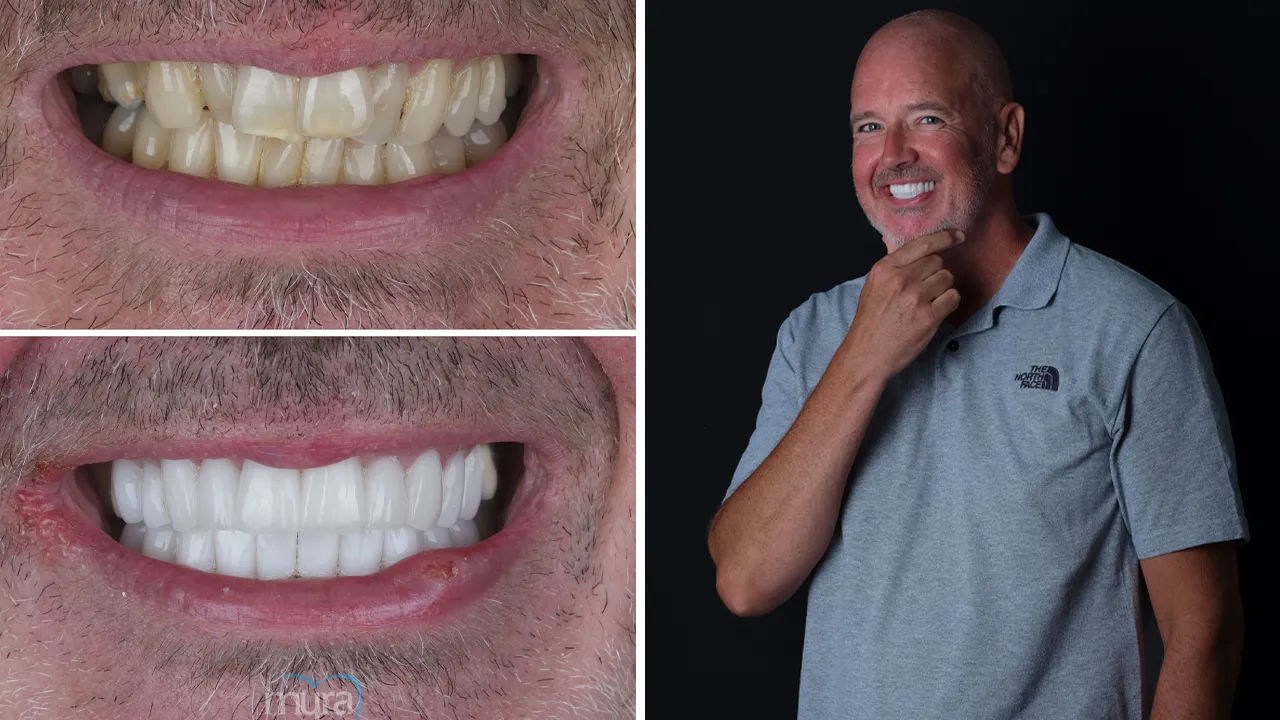
The effect of a narrow smile is a decrease in self-confidence and aesthetics due to the visual imbalance it creates in facial appearance. A narrow smile dramatically lowers one's confidence and self-esteem from an aesthetic perspective. A narrow smile causes one to feel self-conscious and unsatisfied with their appearance. A narrow smile gives the appearance of a less balanced and harmonious facial structure, which influences how a person evaluates their overall beauty. Numerous studies emphasise the value of a confident smile in social interactions, and its link to general well-being corresponds to the psychological influence.
A narrow smile affects one's dental health from a functional standpoint. Maintaining good oral hygiene is difficult when teeth are crowded or out of alignment because of a limited dental arch. Poor oral hygiene increases the risk of dental problems such as cavities, gum disease, and poor breath. A narrow smile causes teeth to be out of alignment, affecting how the teeth fit together when chewing. Misalignment of teeth causes speech difficulties and temporomandibular joint (TMJ) disorders in rare circumstances.
A narrow smile impairs an individual's ability to chew food effectively, leading to digestive issues in the long run. The practical consideration emphasises how crucial it is to treat a narrow smile for aesthetic reasons and to preserve good oral and general health.
How to Fix a Narrow Smile?
To fix a narrow smile, here are the methods to follow.
- Invisalign: Invisalign aligners progressively move teeth into their ideal positions without the need for conventional braces, delivering a discrete and comfortable alternative.
- Braces: Conventional braces use brackets and wires to realign crooked teeth and gradually expand the smile.
- Dental implants: Dental implants widen a narrow smile's appearance by replacing missing teeth and repairing the integrity of the dental arch despite being primarily used for tooth replacement.
- Retainers: Retainers are frequently used after orthodontic treatment to maintain straightened teeth and avoid relapse into a narrow smile.
- Orthodontic treatment: Orthodontic treatment includes a variety of techniques, such as braces and aligners, intended to address misalignment problems causing a narrow smile.
- Surgical procedures: Jaw relocation or bone grafting to broaden the dental arch is required for severe cases of narrow smiles.
- Palatal expanders: Palatal expanders are frequently used in orthodontics to gradually enlarge the palate of the upper jaw, thereby reducing the appearance of a narrow smile.
- Dental crowns: Crowns are affixed to teeth to enhance their size, shape, and look, resolving the issue of a narrow smile.
- Dental veneers: Dental veneers are small, individualised shells glued to the front of teeth to improve the look and provide the appearance of a wider smile.
- Non-surgical options: People resolve small cases of a narrow smile without the need for substantial dental work with the use of non-invasive treatments, including smile exercises, tongue posture corrections, and speech therapy.
1. Invisalign
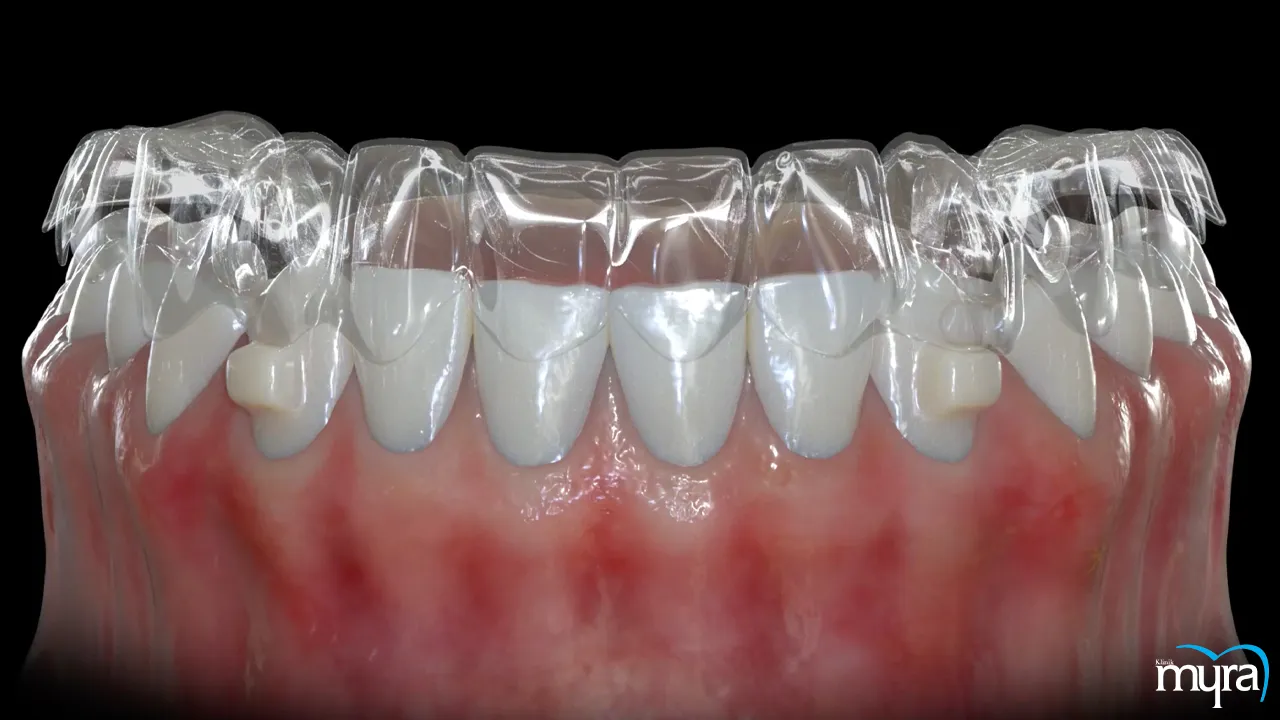
Invisalign is a popular orthodontic treatment method that utilises clear, removable aligners to gradually correct misaligned teeth and improve the appearance of a narrow smile. The unobtrusive alternatives to traditional braces are tailored to fit the patient's teeth precisely and are nearly undetectable while worn. Invisalign is a comfortable and convenient technique to correct dental misalignments, such as ones causing a narrow smile.
The time it takes to correct a narrow smile with Invisalign depends on the individual's specific dental concerns and treatment plan. Invisalign treatment often lasts between a few months and a few years. A narrow smile that is misaligned is treated quickly, while more severe misalignments take longer to correct. Regular check-ups with the orthodontist are required to assess progress and make any necessary alterations to the treatment plan.
Prices for Invisalign in the UK vary greatly depending on factors such as the severity of the case and the patient's location. The normal cost of Invisalign in the UK is between £2,000 and £5,500. A dental professional or orthodontist must be consulted to receive a customised estimate that considers the patient's unique treatment demands and budgetary constraints.
Invisalign has proven incredibly successful in repairing a narrow smile caused by misaligned teeth. Numerous dental disorders, such as crowding, spacing, and minor bite issues, are treated with Invisalign. The patient's cooperation in wearing the aligners as instructed and attending scheduled follow-up appointments is crucial to the treatment's success. Invisalign is a popular option for people who want to improve the appearance of their teeth while maintaining a relatively normal daily routine due to its discretion and comfort. Contacting a trained orthodontist to evaluate if Invisalign is a good solution for one's unique dental difficulties and to discuss the expected outcomes is essential.
2. Braces
Braces are orthodontic devices consisting of metal brackets and wires that are used to correct misaligned teeth and jaws, including addressing a narrow smile. The braces gently move the teeth into their normal locations by applying gentle, regulated pressure. An orthodontist requires periodic modifications to attain the ideal alignment and a broader, more visually pleasing smile.
The duration required to correct a narrow smile with braces varies substantially based on the individual's specific case and the severity of the misalignment. Orthodontic therapy with conventional braces usually takes 18 months to 3 years to complete. More complex situations take longer to finish, whilst simpler cases are completed in less time. The orthodontist monitors development and makes any required modifications during routine checkups.
The type of braces chosen and the dental office's location are two variables that affect the price of braces. The normal price range for metal braces is between £1,500 and £3,000, for transparent braces between £1,500 and £5,500, for self-ligating braces between £2,000 and £6,000, and for lingual orthodontics, between £3,000 and £10,000. A consultation with an orthodontist is required for an accurate cost estimate tailored to one's unique needs.
Braces are particularly effective in repairing a narrow smile since they are designed to realign teeth and broaden the dental arch. Braces straighten the teeth through slow, controlled movements, resulting in a wider, more symmetrical smile. The effectiveness of the treatment is highly dependent on variables such as the patient's adherence to the orthodontist's instructions and the case's complexity. Braces successfully fix narrow smiles in most cases, leaving patients with a more confident and aesthetically beautiful smile at the end of therapy.
3. Dental implants
Dental implants are prosthetic tooth roots made of biocompatible materials, typically titanium, that are surgically inserted into the jawbone to support replacement teeth, such as crowns, bridges, or dentures. Dental implants improve the appearance and usefulness of people who lack teeth by offering a solid and long-lasting solution.
The duration of time needed to fix a narrow smile with dental implants varies depending on the particulars of each case and how complex it is. The implant insertion technique takes several hours, but the entire treatment requires several steps. A dental implant involves the osseointegration process, which takes many months, during which the implant merges with the jawbone. It takes more time to complete the succeeding processes, such as placing the abutment and doing the restoration. The entire procedure for Dental Treatment Implant takes up to a year or longer.
The price of dental implant procedures differs significantly depending on various variables, such as the location, the required number of implants, the materials, and any additional treatments. A single dental implant is expected to cost between £1,500 and £2,500 in the UK. A dentist or oral surgeon must be consulted for a personalised cost estimate and to review payment methods or insurance coverage.
Dental implants are very helpful in situations when lost teeth cause the narrowness of the smile in terms of their ability to treat a narrow smile. Dental implants help restore a wider and more even smile by replacing missing teeth with implants and the proper restorations, such as crowns or bridges. Orthodontic treatments, such as braces or aligners, are more successful in widening smiles for people whose small smile is primarily caused by problems such as crowded or out-of-alignment teeth. A dentist must give the patient a full evaluation before deciding on a treatment. It helps them get to the main reasons for their narrow smile.
4. Retainers
Retainers are dental devices used after orthodontic treatment to keep the teeth's repaired alignment. Retainers are frequently constructed of metal or plastic and are crafted specifically for the patient's teeth. Retainers help stop teeth from moving back into their original locations, ensuring that orthodontic treatment is effective in resolving problems such as a narrow smile over the long run.
The duration of time it takes to fix a narrow smile with braces depends on how bad the problem is and how the person is being treated. Retainers are typically worn constantly for a few months after orthodontic treatment, such as braces or Invisalign, to help stabilise the newly aligned teeth. Patients move from using retainers during the day to wearing them exclusively at night after the initial phase lasts for several years to preserve the correction. The precise timeline must be discussed with the orthodontist, as it differs by case.
Retainers cost between £60 and £400 for each arch when purchased from a private dentist in the United Kingdom. The final cost is determined by several factors, including the type of retainer used, whether removable or fixed, the materials used, the complexity of the case, and the specific costs imposed by the dentist or orthodontist. Speaking with a dental expert to get a personalised price quote based on one's particular requirements is essential.
Retainers are quite good at keeping the teeth fixed alignment, which helps with a narrow smile brought on by misalignment problems. Retainers are an essential part of the orthodontic treatment process and are essential to maintaining the durability of the results brought forth by braces or other orthodontic procedures. The patient's compliance with wearing retainers as instructed by the orthodontist plays a role in their effectiveness, as failing to do so results in a return of tooth misalignment. Utilising retainers is essential for obtaining and keeping the ideal outcomes if they are trying to fix a narrow smile, as the orthodontist advises.
5. Orthodontic treatment
Orthodontic treatment is a specialised area of dentistry that focuses on identifying, avoiding, and resolving jaw and tooth alignment issues. The main component of orthodontic treatment is the gradual movement of teeth into their ideal positions using various tools, such as braces or aligners, to produce a more aligned and aesthetically acceptable smile.
The duration of time needed to correct a narrow smile with orthodontic treatment varies greatly depending on how serious the problem is and the technique used. Procedures such as Invisalign or temporary braces often fix mild to moderately narrow smiles in as little as 6 to 12 months. More difficult situations take 18 months or longer to obtain the desired results. An orthodontist evaluates the patient's unique needs during the initial appointment to determine the precise timing.
The cost of orthodontic treatment for a narrow smile varies greatly depending on several factors, including the type of treatment, the intricacy of the case, and the dental practice's geographic location. Traditional braces typically cost between £1,500 and £6,000 in the UK. less than more covert alternatives such as Invisalign. Individuals considering orthodontic treatment must speak with an orthodontist who provides a personalised cost estimate and payment plans or insurance coverage options.
Orthodontic treatment is highly effective in rectifying a narrow smile when administered by a skilled and experienced orthodontist. The treatment produces a more even-looking and balanced smile by progressively moving teeth into their right locations, widening dental arches, and aligning the bite. Patient compliance is vital to the success of the treatment since it ensures that the orthodontist's recommendations are followed and scheduled appointments are kept. Orthodontic treatment is a tried-and-true technique for widening smiles, resulting in better oral health and more self-confidence.
6. Surgical procedures
Surgical procedures to fix a narrow smile include several procedures, such as orthognathic surgery and bone grafting. Orthognathic surgery realigns the upper or lower jaw to fix jaw misalignments, broadening the dental arch and enhancing the appearance of the smile. Bone grafting includes adding bone tissue to the jaw to widen it and make room for properly positioned teeth. Oral and maxillofacial surgeons often carry out these surgical treatments, which are advised for more severe cases of narrow smiles where orthodontic or non-surgical methods are not always effective.
The time needed to correct a narrow smile by surgery varies greatly depending on how complicated the situation is. Surgical procedures typically take several hours to complete, and the total length of the treatment programme ranges from a few months to more than a year. The timeframe includes pre-surgery evaluations, recovery time, and follow-up appointments. Patients must speak with their oral surgeon to acquire a more precise estimate depending on their unique situation.
The costs of surgical treatments to widen the smile are high and are impacted by several elements, such as the surgeon's experience, the patient's location, the cost of the hospital or clinic, the cost of the anaesthesia, and the intricacy of the process. For instance, orthognathic surgery in the United Kingdom costs between £4000 to £6000. Individuals considering these procedures must visit with their healthcare practitioner or surgeon to acquire a thorough cost estimate and to investigate insurance coverage alternatives.
A narrow smile typically improves through surgery, especially when a misaligned jaw or weak bone structure brings it on. Surgical procedures are customised to meet the individual requirements of each patient, resulting in a more even-looking smile. The effectiveness differs depending on certain conditions and the surgeon's expertise. It is essential to have realistic expectations and to consult with a qualified oral and maxillofacial surgeon to determine the most appropriate surgical approach and to evaluate prospective outcomes. Patients frequently notice notable improvements in the appearance and functionality of their smiles after having a narrow smile surgically corrected.
7. Palatal expanders
Palatal expanders are orthodontic appliances used to increase the width of the palate in the upper jaw. Palatal expanders are made of a metal framework with screws that progressively separate the upper jaw's bones by gently pressing on the palate. The separation makes more space in the mouth, enabling the correction of problems, including a small smile, tooth crowding, or an unaligned bite. Palatal expanders are frequently incorporated into orthodontic treatment regimens to address these issues.
The duration of time needed to use a palatal expander to treat a narrow smile varies depending on the severity of the problem and the particular patient's circumstances. The duration of the treatment's expansion phase ranges from a few weeks to many months. The patient often wears a retainer for a while after reaching the target width to keep the results. The total treatment time, including expansion and retention, lasts anywhere from six months to a year or more.
The cost of a palatal expander procedure varies depending on several factors, including the location of the dentist or orthodontic office, the complexity of the case, and the particular expander made use of. A palate expander typically costs between £1,000 and £2,500 in the UK. A patient must speak with an orthodontist to receive a precise quote that is suited to their unique requirements and situation. Insurance coverage helps offset some of the expenses depending on one's plan.
Palatal expanders are successful in treating a narrow smile brought on by a tight upper jaw. Palatal expanders function by progressively and safely enlarging the palate, enabling optimal tooth alignment and enhancing facial harmony. The patient's age mostly determines the treatment's effectiveness, the depth of the narrowing, and adherence to the orthodontic plan. Palatal expanders result in considerable and long-lasting improvements in appearance and function when a restricted upper jaw causes a narrow smile. A skilled orthodontist must be consulted to ascertain whether such type of therapy is appropriate for specific dental issues.
8. Dental Crown
A dental crown is a dental prosthetic device used to cover and protect a damaged or weakened tooth. A dental crown restores the native tooth's appearance, strength, and functioning by being manufactured specifically to match the natural tooth's size, shape, and colour. Dental crowns are frequently employed in various dental operations, including those that address problems with a narrow smile, such as adjusting tooth size and alignment.
The duration needed to fix a narrow smile with dental crowns varies based on the case's complexity and the number of teeth affected. The procedure typically consists of several processes, including tooth preparation, impression taking, crown fabrication, and fitting. The entire process often takes a few weeks, allowing for the construction of a personalised crown that fits precisely. Simpler scenarios take less time, whereas more complicated ones, perhaps more.
The cost of dental crowns is between £650 and £800 in the UK. The cost varies from clinic to clinic and is affected by the clinical follow-up policy and location within Turkey. The cost of the treatment is impacted by the nation in which it is performed, the experience of the dentist and dental technician, and the size of the dental crown. Prices for dental crowns are frequently at least three times less expensive in Turkey than in many other European nations. Prices inside Turkey vary by city, with Antalya frequently seen as the more affordable choice for dental care.
Dental crowns are a very efficient way to improve some characteristics of a narrow smile, especially if the teeth are malformed or undersized. A dentist improves the teeth's appearance and produces a wider, more even smile by applying custom-made crowns on them. The dentist's skill and experience in creating and installing crowns affect the treatment's efficacy. Dental crown is a useful cosmetic dentistry tool, but their effectiveness in widening a narrow smile is determined individually. Other orthodontic or cosmetic procedures are more appropriate for some patients.
9. Dental Veneers
Dental veneers are thin, individualised covers for the front of teeth that are often constructed of porcelain or composite resin. Dental veneers are utilised for fixing a variety of cosmetic concerns with teeth, such as discolouration, slight misalignment, gaps, and cracked or damaged teeth. A natural-looking and long-lasting way to improve the attractiveness of a person's smile is using veneers.
The duration it takes to fix a narrow smile with dental veneers depends on a variety of variables, including the individual's unique condition and the quantity of veneers required. The procedure requires two to three appointments spread out over a few weeks. Consultation and preparation are done during the first session, imprints are taken, veneers are made, and the bonding technique is done. The duration of the process is anywhere from a few weeks to a few months.
Dental veneer prices vary widely depending on several variables, such as the type of material used, including composite resin or porcelain, the location of the dental office, and the number of veneers needed. Zirconium veneers cost about 200 euros, and Lumineers cost as little as 250 euros. The dental veneers cost between £500 to £1,000 per tooth in the UK. It's essential to remember that some insurance plans do not pay for cosmetic treatments such as veneers, forcing people to visit private clinics, which are much more expensive.
Dental veneers effectively fix a narrow smile, especially when tiny gaps, misalignments, or irregularities in tooth size or shape cause the problem. Veneers make teeth appear larger and more uniformly spaced, enhancing the smile's symmetry. The exact state of the patient's teeth and the dentist's suggested course of treatment determine their success. Other orthodontic treatments are more suitable for people with serious misalignment or orthodontic problems causing a narrow smile, such as braces or aligners. A patient must consult a knowledgeable dentist or orthodontist to choose the best course of action for treating a narrow smile, which includes options such as dental veneers.
10. Non-surgical option
Non-surgical options for fixing a narrow smile include a variety of methods and treatments without the use of braces or other invasive dental procedures. Non-surgical options focus on modifying habits, correcting posture, and engaging in exercises to treat minor cases of a narrow smile. For instance, fixing the tongue's posture promotes the normal growth of the upper arch, which naturally widens the smile. The function of the tongue and oral muscles is improved with speech therapy, which has a knock-on effect on the smile's width. Non-surgical options are considered for people with minor cosmetic issues with a narrow smile and are suggested by a dentist or orthodontist.
The duration it takes to fix a narrow smile using non-surgical options varies greatly depending on the treatments utilised and the severity of the narrowness. A few weeks to a few months of consistent therapy or exercise are necessary for mild cases before changes become obvious. More significant changes take longer, from several months to a year or more. It is essential to realise that non-surgical options frequently demand commitment and perseverance because outcomes are not as quick as the ones obtained through orthodontic or surgical treatments.
Non-surgical options are less expensive financially than orthodontic or surgical procedures to widen a small smile. Costs vary depending on criteria such as the type of therapy or exercises suggested, the frequency of meetings with specialists if necessary, and geographic location. Simple speech therapy exercises or tongue position correction are two non-surgical methods that come with low costs. It is advised to speak with a dentist or orthodontist to determine the best non-surgical course of action for one's particular situation and to obtain a precise idea of the costs involved.
The success of non-surgical treatments for treating a narrow smile depends on the patient's particulars, such as the seriousness of the problem and their dedication to adhering to the recommended therapies or exercises. Non-surgical options are most effective in mild cases and as part of a comprehensive treatment plan that includes lifestyle adjustments and oral hygiene improvements. Non-surgical options do not produce as dramatic results as orthodontic treatments or surgery, but they are a valuable and less invasive solution for people seeking minor cosmetic smile enhancements. A knowledgeable dental practitioner helps patients decide whether non-surgical methods are appropriate for their particular needs by consulting with them.
What is the fastest way to fix a Narrow Smile?
The fastest way to fix a narrow smile is through the use of dental veneers. Dental veneers are small, custom-fitted shells of porcelain or composite resin that are affixed to the front of teeth to enhance their appearance. Dental veneers give the appearance of a wider smile by concealing and altering the visible parts of teeth even though veneers do not physically enlarge the dental arch, compared to orthodontic procedures.
Dental veneers are applied in a few dentist visits, sometimes within a few weeks. The procedure starts with an initial consultation to discuss the patient's goals and preferences, followed by dental preparation and veneer application. Veneers quickly provide a wider, more visually pleasing smile compared to orthodontic treatments, which take months or even years to complete.
Dental veneers are highly effective at fixing many cosmetic problems with a narrow smile. Dental veneers fix problems such as gaps, discolouration, misalignment, and minor tooth anomalies, all of which make a smile appear less attractive. They are a quick and effective alternative for people looking to transform their smiles quickly without undergoing substantial dental work due to their adaptability.
Dental veneers are an excellent alternative for people seeking a quick and long-lasting fix because their resilience assures that the effects are long-lasting. Veneers provide a dependable way to quickly transform a smile into one that is more appealing by maintaining its appearance and performance with the proper care and upkeep.
Can you fix a narrow smile without getting a surgical procedure?
Yes, you can fix a narrow smile without getting a surgical procedure. There are non-surgical options for treating a narrow smile, and such methods are typically effective for mild to moderate cases. The non-surgical methods mostly concentrate on dental and oral treatments and lifestyle modifications to enhance the smile's attractiveness. For example, the dental arch is widened without surgery by using orthodontic procedures such as braces or Invisalign. A broader smile is created without surgery with dental veneers, which are thin shells attached to the front of teeth. Improved oral muscle function leads to a wider, more aesthetically pleasing smile due to speech therapy, tongue posture correction, and other non-invasive methods. A patient must consult a dentist or orthodontist to decide the best non-surgical course of action based on the severity of their narrow smile and their unique objectives.
What is the best clinic for fixing a Narrow Smile?
The best clinic for fixing a narrow smile is the Myra Dental Centre Turkey. The Myra Dental Centre is well known for its proficiency in restorative and cosmetic dentistry, and it provides a wide range of procedures to address various dental issues, including narrow smiles.
Myra Dental Centre has a team of highly qualified and experienced cosmetic dentistry specialists on staff. Their success in improving smiles is well documented, even for people with narrow dental arches. The clinic's staff is committed to delivering individualised, patient-centred care and ensuring that individual needs and objectives are expertly and professionally satisfied.
Myra Dental Centre has cutting-edge dental technologies and amenities. Advanced treatment options and accurate diagnostics are made attainable by such modern technology. The clinic has access to cutting-edge instruments and techniques to get the best outcomes in the fastest manner, whether it be through orthodontic operations such as braces or aligners, dental veneers, or other non-surgical approaches.
Myra Dental Centre is renowned for its dedication to the satisfaction and comfort of patients. They place a high value on creating a relaxed and stress-free environment for their patients to make the healing process enjoyable. The Myra Dental Centre ensures that patients obtain high-quality care without going over budget by providing fair prices and open treatment options.
Turkey is a great place for medical and dental tourism because it is much cheaper than many Western countries. Turkey is a popular destination for dental patients from around the world since it is so affordable, and Myra Dental Centre stands out among the competition in a crowded field.
How to avoid Narrow Smile?
To avoid a narrow smile, here are some key strategies to follow.
- Orthodontic Evaluation: Orthodontic evaluations must be scheduled for kids at a young age to catch any alignment abnormalities early and fix them.
- Dental Checkups: Arrange routine dental exams to monitor oral health and quickly address any abnormalities that arise.
- Lifestyle Habits: Avoid habits such as nail-biting or using teeth as tools, which cause dental damage and misalignment, which contribute to a narrow smile.
- Professional Guidance: Speak with a dentist about the unique risk factors to provide tailored advice on how to keep the teeth healthy and properly aligned.
- Oral Hygiene: Maintain appropriate oral hygiene practises, such as brushing, flossing, and using mouthwash regularly, to avoid oral health issues that contribute to a narrow smile.
- Diet: Eat a well-balanced diet rich in vitamins and minerals that are needed for dental health. Avoid consuming too many sweet or acidic meals or drinks because they cause tooth decay.
- Thumb-Sucking and Pacifier Use: Prevent youngsters from continuing such bad habits after they reach the recommended age by discouraging thumb-sucking and pacifier use.
- Breathing and Tongue Posture: Encourage adequate breathing through the nose rather than the mouth, and encourage the proper tongue position to help the development of a strong dental arch.
- Orthodontic Treatment: Patients must speak with an orthodontist about the best course of action, such as braces or aligners, to stop the narrow smile from getting worse if alignment problems occur.
- Protective Gear: Wear mouthguards while participating in sports to protect oneself from severe injuries that damage the teeth's alignment and cause a narrow smile.
How much does it cost to fix a Narrow Smile?
The cost to fix a narrow smile ranges from £1,000 to £6,000 or more in the UK, depending on the treatment method and the severity of the issue. Several factors impact the price of treating a narrow smile, such as the extent of the problem, the technique of treatment selected, the location of the dentist's office, and any extra treatments necessary.
Non-surgical solutions such as dental veneers or orthodontic procedures like braces or aligners fall within the lower end of the cost range, with prices ranging from £1,000 to £3,000. Dental veneers are thin shells bonded to the front of teeth to enhance their appearance and are a quicker and more economical option for minor cosmetic issues related to a narrow smile.
More intensive orthodontic procedures for moderate to severe cases of narrow smiles cost £3,000 to £6,000 or more. The cost of orthodontic procedures varies depending on the type of treatment chosen, the length of therapy, and the case's complexity.
Surgery to repair a narrow smile, such as jaw relocation or bone grafting, runs significantly higher between £5,000 and £10,000. Surgery is used in extreme circumstances and frequently calls for specialised knowledge.
A dentist or orthodontist proposes a specific course of treatment, and it's essential to remember that these price ranges are approximations and subject to substantial variation. Dental insurance coverage helps reduce some of the costs. Patients must speak with a dental expert and their insurance company for a more precise cost estimate and to look into available financial assistance alternatives.
What is the most affordable way to fix a Narrow smile?
The most affordable way to fix a narrow smile is through dental bonding treatments. Dental bonding is a low-cost cosmetic surgery that includes coating teeth with a resin material that matches their natural colour to make them appear better. Dental bonding is a good solution for people with minor cosmetic issues with a narrow smile.
Dental bonding is more affordable because it needs little dental preparation and is finished in just one appointment with the dentist. The technique begins with slightly roughening the tooth surface, followed by the application of the resin substance, moulding it to create the desired appearance, and curing it with a specific light. Dental bonding has a lower initial cost as compared to more involved procedures such as braces, veneers, or orthodontics.
Dental bonding treats various aesthetic problems that contribute to a narrow smile, such as tiny gaps, slight misalignments, and discoloured or broken teeth. The appearance of teeth is greatly improved, leading to a more aesthetically pleasing smile, even though it does not transform teeth to the same extent as some other treatments.
What is the difference between a Narrow Smile and a Gummy Smile?
The difference between a narrow smile and a gummy smile is that a narrow smile is characterised by closely spaced or misaligned teeth, while a gummy smile is defined by the excessive display of gum tissue when smiling. A narrow smile is one in which the teeth are closely spaced and do not adequately occupy the mouth's dimensions. The teeth do not fill the complete area within the dental arch due to problems, including crowding or misalignment. A gummy smile happens when a sizable section of the upper gums is visible when someone smiles. The condition often arises from the teeth having too much gum tissue covering them, making the teeth look shorter and the gums more noticeable.
The difference between a narrow smile and a gummy smile are listed below.
- Focus of Concern: A narrow smile mainly relates to the positioning of the teeth in the mouth, particularly in terms of their alignment and spacing. A gummy smile focuses on how prominent the gums are when smiling, especially the top gums.
- Appearance: A narrow smile has teeth that are too close together, making the smile appear thin or crowded. A gummy smile gives the impression that the teeth are shorter than they are because of too much gum tissue.
- Underlying Causes: Narrow smiles are frequently the result of teeth misalignment, crowding, or spacing difficulties. Gummy smiles are brought on by excessive gum tissue, which is heredity, specific medical diseases, or problems with the alignment of the upper jaw or teeth.
- Treatment Methods: A narrow smile is typically treated with orthodontic procedures such as braces or dental veneers to correct teeth alignment and spacing. Treatment options for a gummy smile include gum contouring or gum reduction surgery to remove extra gum tissue and display more teeth.

